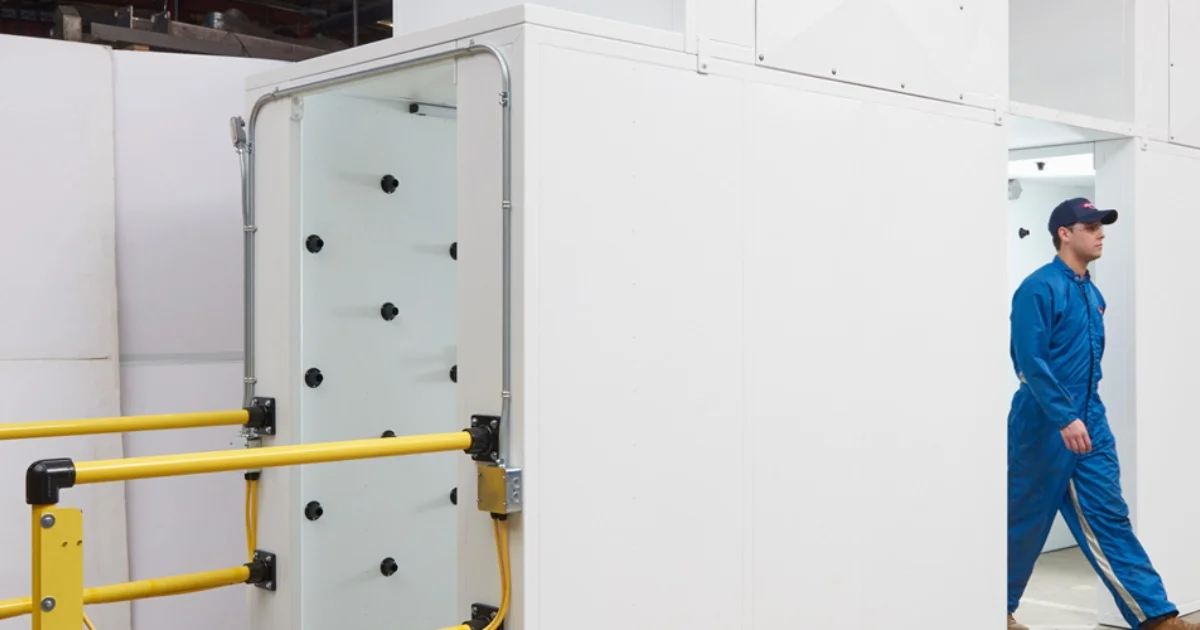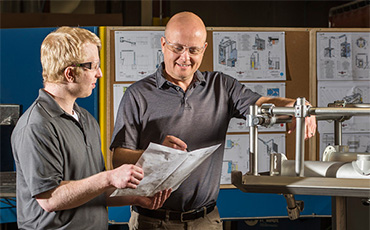
Blow off systems are necessary for a wide range of drying, cooling, and cleaning applications in industrial and manufacturing settings. However, these systems can be noisy – which, left unchecked, can become a workplace hazard.
Not only do regulatory agencies enforce noise limits, but companies recognize that quieter workplaces directly impact bottom-line results. Worker retention, production quality, and even energy efficiency all improve when excessive noise is tamed.
Many facilities discover that addressing blow off system noise delivers a significant return on investment.
You don’t have to compromise on performance to reduce noise pollution from blow off systems. This post discusses practical ways to use system design, sound barriers, smart placement, and regular upkeep to make your blow off operations quieter and more efficient.
Understanding Noise Pollution in Blow Off Systems
Before fixing noise pollution from blow off systems, you need to know what causes it. Identifying these causes is the first step toward effective noise management and regulatory compliance.
High-velocity air turbulence: When air rushes through pipes, fittings, and nozzles, it creates pressure waves that turn into sound. Higher air speed means louder noise.
Mechanical vibrations: Blowers, compressors, and moving parts add to the noise. These vibrations can travel through mounting structures and spread throughout your facility.
Reflection and resonance: Hard surfaces in factories bounce sound waves back, creating echoes that amplify noise. Some pipe setups can also create resonance that makes certain sounds louder.
Addressing these factors can help control noise while keeping your system effective.
Health and Safety Impacts
Loud noise doesn't just annoy workers – it can hurt them. OSHA says exposure to noise levels above 85 decibels (dB) over an 8-hour shift requires hearing protection. Many blow off systems exceed 90-95 dB, well above this limit.
Long-term exposure to high noise levels can cause permanent hearing loss, increased stress and fatigue, reduced concentration, and higher accident rates. Workers also struggle with communication in noisy environments, which can create safety risks.
Reducing system noise protects your workers and helps you comply with safety regulations.
Strategies to Reduce Noise Pollution

1. Optimize Blower System Design
Choosing the right equipment can have a significant impact on blower noise reduction. Low-noise blowers with modern designs minimize turbulence and reduce noise output. Variable Frequency Drives (VFDs) adjust airflow based on demand, preventing excessive speeds and noise when full power isn't needed.
High-efficiency nozzles and air knives control airflow better than standard options, reducing turbulence and noise while maintaining cleaning effectiveness.
Direct Drive Blowers provide a quieter alternative to traditional blower systems.
AF1 designs precision air delivery systems that optimize airflow while keeping noise levels low. Our systems help maintain a quieter, more efficient workspace.
2. Implement Acoustic Enclosures & Soundproofing
Industrial noise control solutions, such as acoustic panels and enclosures, significantly reduces workplace noise.
Sometimes, you need physical barriers to contain noise at its source. Sound-absorbing enclosures surround noisy equipment and trap sound waves before they spread. Vibration isolation mounts prevent vibrations from transferring to building structures and becoming airborne noise.
Adding acoustic panels to walls and ceilings reduce echo and reverberations in your facility. The right sound barriers can reduce noise levels by 15-25 dB when properly installed.
Material Options
When considering soundproofing for industrial equipment, the choice of materials matters. AF1's Blower Sound Control Enclosures are specifically designed for blower noise reduction in industrial settings.
Adding enclosures and acoustic barriers is a proven method of soundproofing for industrial equipment. These solutions can be customized to fit your specific equipment while maintaining accessibility for maintenance.
3. Optimize System Placement & Layout
Where you put your equipment greatly affects noise levels throughout your facility. Locating noisy equipment away from workstations uses distance to naturally reduce sound intensity. Avoid placing equipment near reflective surfaces like hard walls that amplify noise through reflection.
Using barriers between noise sources and work areas can significantly reduce perceived noise. Even partial walls help block direct sound paths. Consider directional airflow by pointing air streams away from work areas when possible.
Strategic Considerations
Place blowers in separate rooms, on the roof, or behind barriers when possible.
Install sound-absorbing materials on walls near blow off equipment to reduce reflections.
Creating dedicated zones for noisy operations helps contain sound within specific areas.
Use natural building features to block sound paths whenever possible.
AF1 helps clients determine optimal equipment placement, considering both performance and noise control in facility layouts.
4. Conduct Regular Maintenance & Inspections
Regular maintenance plays a key role in workplace noise reduction by preventing excess vibration and leaks.
Even well-designed systems get noisier over time without proper care. Check regularly for loose components and tighten connections, mounts, and fasteners before they create excess vibration. Look for worn bearings and moving parts and replace them before they cause excessive noise.
Keep air filters clean, as clogged filters make systems work harder and louder. Inspect for air leaks, since even small leaks create high-frequency noise and waste energy. A good maintenance program prevents small issues from becoming noisy problems.
Maintenance Schedule
Weekly: Perform visual inspections and listen for unusual noises to detect early problems.
Monthly: Clean filters and tighten loose connections.
Quarterly: Inspect all mounting hardware and vibration isolators to prevent long-term degradation.
Annually: Conduct a full system evaluation, including airflow testing, to ensure optimal performance.
Our equipment is designed for easier maintenance, helping you maintain optimal acoustic performance throughout the system's life.
Measuring Noise Levels
To effectively reduce noise, you need to know your starting point and track improvements. Measuring workplace noise helps identify problem areas and document progress.
Using Sound Level Meters
Sound level meters measure noise intensity in decibels (dB). When measuring, take readings at operator positions where workers spend most of their time. Measure during typical operations to get accurate real-world readings. Document both average and peak noise levels to understand the full exposure picture.
Consider frequency analysis to target specific noise types, as different frequencies require different solutions. A baseline noise survey helps prioritize which areas need attention first and provides comparison data to show improvements.
Understanding Decibel Measurements
The decibel scale is logarithmic, meaning small reductions make big differences in perceived loudness. A 3 dB reduction cuts sound energy in half, while a 10 dB reduction makes noise seem half as loud to the human ear.
This logarithmic nature explains why even modest noise reductions of 5-8 dB can transform a workplace environment. When companies implement targeted noise controls, these seemingly small improvements can bring noise levels below critical regulatory thresholds and dramatically improve workplace communication.
Cost-Benefit Analysis
Companies that invest in workplace noise reduction see improvements in productivity and worker satisfaction. Investing in noise reduction delivers multiple benefits beyond compliance.
Reduced risk of hearing loss claims is significant – avoiding a single workers' compensation claim can offset the cost of basic noise controls. Improved productivity comes with quieter environments, with studies showing increases in noise-reduced settings.
Lower energy costs often accompany noise reduction solutions as they improve system efficiency. Better communication happens naturally in quieter settings, improving teamwork and safety. Reduced absenteeism is another benefit, as noise-related stress contributes to sick days and employee turnover.
Most noise reduction projects pay for themselves through efficiency gains and avoided costs, making them smart business investments beyond their health benefits.
Regulatory Compliance
Managing noise pollution from blow off systems effectively helps businesses navigate the complex regulatory landscape. OSHA Standard 1910.95 requires hearing conservation programs when noise exceeds 85 dB over 8 hours, while EPA guidelines address environmental noise affecting areas beyond your property lines.
Local ordinances often set stricter limits, especially near residential areas. Many industries also have specific noise guidelines that apply to particular processes or equipment. Addressing noise issues proactively prevents costly retrofits that might be required following enforcement actions and helps maintain your reputation as a responsible business.
Creating a Quieter, More Productive Environment
When you lower noise pollution from blow off systems, you create safer working conditions and enable clearer communication. Noise reduction delivers benefits that extend throughout your operation. Workers experience less fatigue and can focus better on quality and precision tasks. These improvements translate directly to your bottom line through higher productivity and fewer errors.
Your noise reduction journey should begin with measurements. Use a sound level meter to identify your loudest equipment and processes. Focus first on areas where workers spend the most time and where noise exceeds 85 dB. Document your findings to establish a baseline and set improvement targets.
Small changes often make significant differences. Engineered nozzles can replace standard blow offs, reducing noise by 8-10 dB while using less compressed air. Basic sound barriers around noisy components can block direct sound paths to work areas. Even simple equipment maintenance – tightening loose parts, replacing worn bearings, and fixing air leaks – can substantially lower noise levels.
For tougher noise challenges, consider working with acoustic specialists. AF1's engineering team can analyze your specific application and design customized solutions that maintain performance while reducing noise. Our approach ensures you achieve noise compliance without sacrificing the effectiveness of your processes.
Ready to transform your workplace environment? Take the first step by identifying your noisiest blow off applications. Implement one improvement this month and measure the results. As noise levels decrease, watch for improvements in communication, accuracy, and worker satisfaction. Your quieter workplace will become a competitive advantage that benefits everyone.

